
The flag of Puerto Rico shows five identical broad horizontal stripes in red, white, red, white and red, as soon as a blue isosceles triangle on the pole with a white five-pointed star in it. It was hoisted for the first time on 22nd of December in 1895, but had only an unofficial status. There was to use solely the flag of the USA. On 24th of July in 1952 became that flag officially tooken over as flag of the associated free state, but it is just allowed to hoist it together with the flag of the USA. The flag of Puerto Rico has its roots in the flag of Cuba: It was created for Cuba in the year 1849 – in exactly the same design like the today's flag of Puerto Rico – by the Venezuelan General Narciso López in his New York exile for the Cuban fight for freedom. In the same year the colours of the flag became inverted by the Cuban poet Miguel Teurbe Tolon. That Cuban flag was in use for the first time at the great Anti-Spanish riot in Cuba in the year 1850. The red triangle of Masonic origin and stands for freedom, equality and brotherliness. The colour red stands for the in the struggle against the Spaniards given blood and white stands for purity, equality and peace. The white star (La Estrella Solitaria) is a symbol for freedom and equality, and should initially express that there has to add a further state to the USA. Red, white and blue are also clear references to the "Stars and Stripes" of the USA. The Puertorican division of the Cuban Revolutionar Party adoped because of solidarity with the fight for freedom of the Cubans against the Spanish in the year 1890 a flag, which corresponded in its designing to the flag of Cuba, but the colours became inverted to show a special, national and Puertorican identity. The colours of the flag are defined by law in 1952, but only as red and blue, without specifying more precisely. Since then, the triangle has been depicted in a dark blue similar to that of the United States flag. Since 1995, however, lighter shades of blue have been used. Today's colours seem to be defined from practice and could be represented as follows: Red = pt 1788, Blue = pt 2728. The flag is found in practice in a wide variety of shades.
Flag-Dispute:
The flag (and in the same way the logo) of the shipping company DSD was created in the year 1903 on the occasion of an internal competition by the helmsman Ommund Thingbø, who won the competition. The ships of the DSD were flaged accordingly and the chimneys were also painted with three red rings. Puerto Rico, which became affiliated to the United States in 1900 as a non-organized territory, claimed the rights for the design of the flag. It was assumed that the design was the same and that it had already been created in Puerto Rico in the year 1895 and thus had older rights. In the years of 1950, Puerto Rico first claimed via the Norwegian Ministry of Foreign Affairs to change the flag. A court ruled that there was no break of international rules, even if the flag was in use many years before its launch in the DSD in Puerto Rico, where this flag was officially approved not until 24th of July in 1952 in occasion of the introduction of a new constitution, when Puerto Rico became an Associated Free-State of the United States (also called Dominion, or Commonwealth). However, Puerto Rico is not an independent and sovereign state until today, and its flag may be hoisted on public buildings only along with the flag of the United States. Further, the design of DSD and Puerto Rico differs from each other in a not unimportant detail. The white Star in the blue triangle in Puerto Rico is slightly smaller and straight, at DSD slightly larger and slanted.
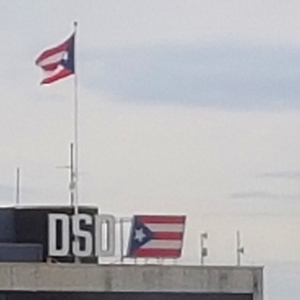
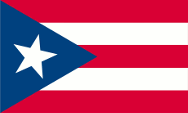
Source/Foto: Volker Preuß, DSD-Shipping
On the left the flag of the DSD (Det Stavangerske Dampskibsselskap) on its building in the port of Stavanger in Norway on 23rd of August in 2018. Beneath it is realized as a graphic.
Source: Flags of the World, Wikipedia (ES), Wikipedia (ES)

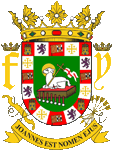
Coat of arms of Puerto Rico,
Source, by: unknown

The main element of Puerto Rico's coat of arms is the Lamb of God with a cross flag on a green shield, they are the symbols of John the Baptist. The green represents the vegetation of the island. Although Puerto Rico is a US territory, the shield still has elements that recall Spain's presence in America. It was awarded in 1511, abolished in 1899 and restored in 1905. The current version was officially adopted by the government of Puerto Rico on 3rd of June in 1976. In the shield border, fields alternate with the heraldry of Castile, León, Castile-León and Jerusalem. To the left and right of the coat of arms appear the letters "F" (Ferdinand II. of Aragon) and "Y" (Ysabel, Isabella I. of Castile). The banner shows the saying: "JOANNES EST NOMEN EJUS" → "John is his name". A reference to John the Baptist, but also to the old name of the island: "San Juan Bautista".
Source: Wikipedia (EN)

Location:
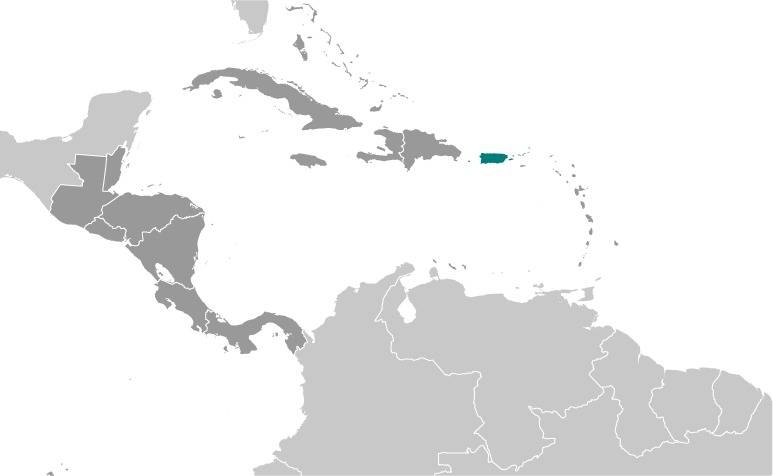
Source: CIA World Factbook
Map of the country:
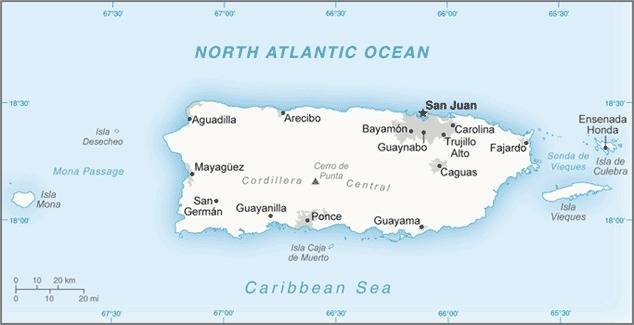
Source: CIA World Factbook

Area: 3.515 square miles
Inhabitants: 3.193.694 (2019), thereof 75% Europeans, 12% Blacks
Religions: 70% Roman Catholic, 12% Protestant
Density of Population: 909 inh./sq.mi.
Capital: San Juan, 342.259 inh. (2020)
official Languages: Spanish and English
Currency: 1 US-Dollar (USD, $) = 100 Cents
Time Zone: GMT – 4 h
Source:
Wikipedia (DE)

1493 · discovery of the island by Christoph Columbus
1508 · beginning colonization by Spain under Juan Ponce de León
1511 · Indian revolt, eradication of the Indians
1518 · import of Negro slaves
1521 · foundation of San Juan (at that time: San Juan Bautista de Puerto Rico)
1815 · Puerto Rico becomes granted freedom of trade
1835 · anti-colonial revolt
1838 · anti-colonial revolt
1867–1868 · anti-colonial revolt
1873 · abolition of slavery
1897 · granting of internal autonomy
21st of April to 10th of December 1898 · Spanish-American War (1st of May 1898: victory of the USA in the sea-battle in the Manila Bay, 12th of June 1898: the Philippines proclaim the independence, June 1898: conquest of Puerto Rico by US-American troops, 3rd of July 1898: victory of the USA in the sea-battle of Santiago de Cuba, 13th of August 1898: US troops occupy Manila, 14th of August 1898: surrender of the Spanish troops on the Philippines)
10th of December 1898 · Peace of Paris, Spain cedes the Philippines, Cuba, Puerto Rico and Guam to the USA
1900 · affiliation to the USA as "non-organized territory"
1917 · granting of the citizenship of the USA and of limited self administration (Jones-Act)
1926 · anti-colonial revolt
1936–1937 · anti-colonial revolt
1948 · extension of the limited self administration (right for the election of an own governor)
1950 · armed, anti-colonial resistance
1952 · new constitution, Puerto Rico becomes an associated free state of the USA (Dominion, Commonwealth)
1967 · plebiscite, rejection of the independence with a big majority
14th of December 1973 · the UNO recognizes the right of Puerto Rico for its independence
13th of December 1998 · plebiscite: 50,2% reject an incorporation in the USA as 51st federal state
Source:
Atlas zur Geschichte,
Wikipedia (D),
Discovery '97,
Weltgeschichte

The name of the island has its roots in the name of the in 1521 established town of " San Juan Bautista de Puerto Rico", the today’s "San Juan". The name of the town became very quickly transfered over the whole island. "Puerto Rico" means "rich harbor".
Source: Handbuch der geographischen Namen


![]()

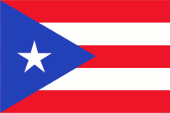





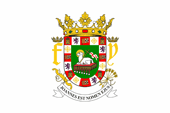
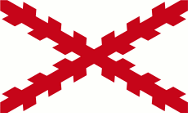
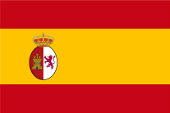



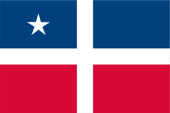



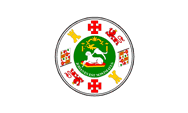
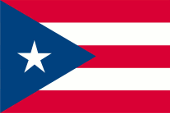





![]()
